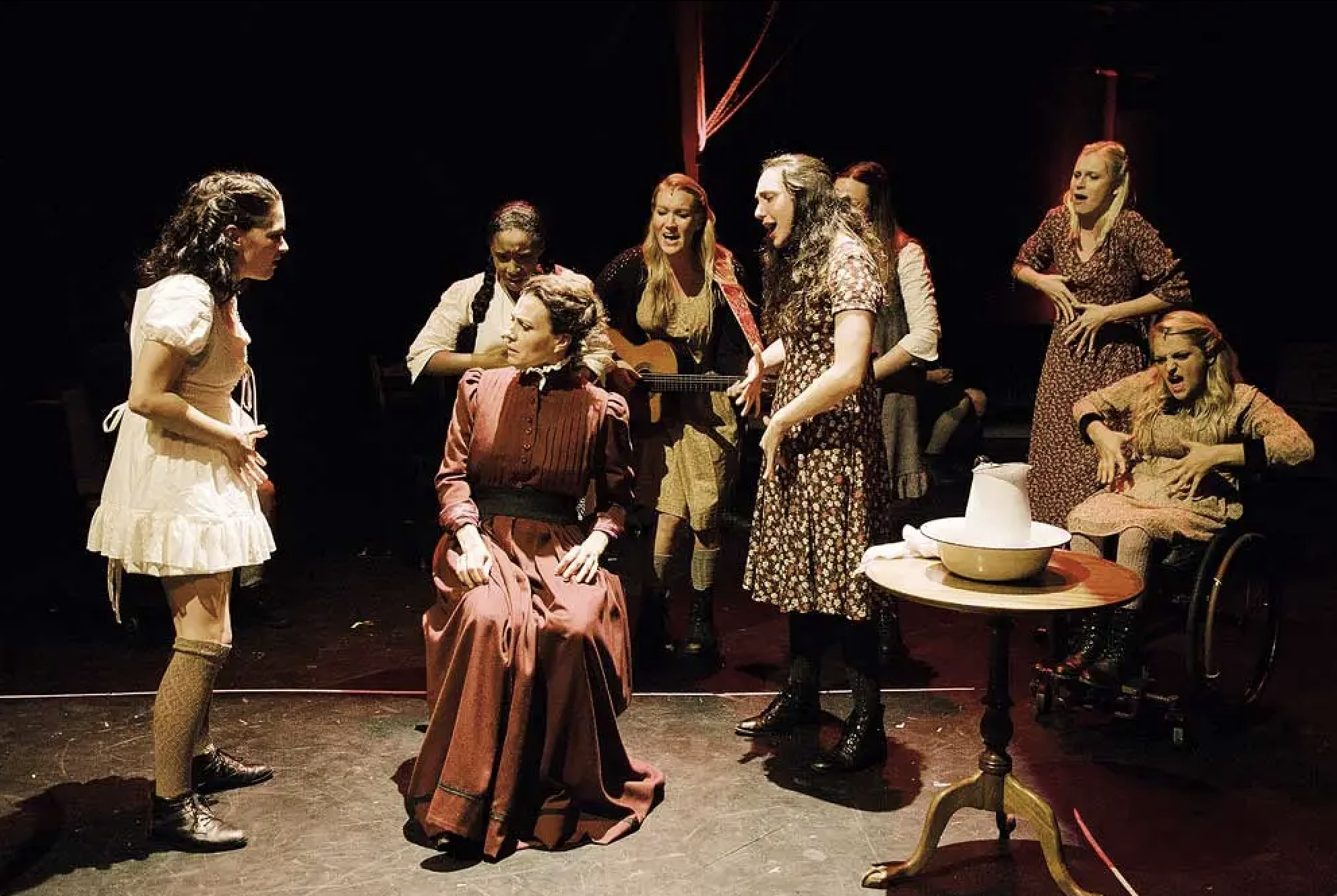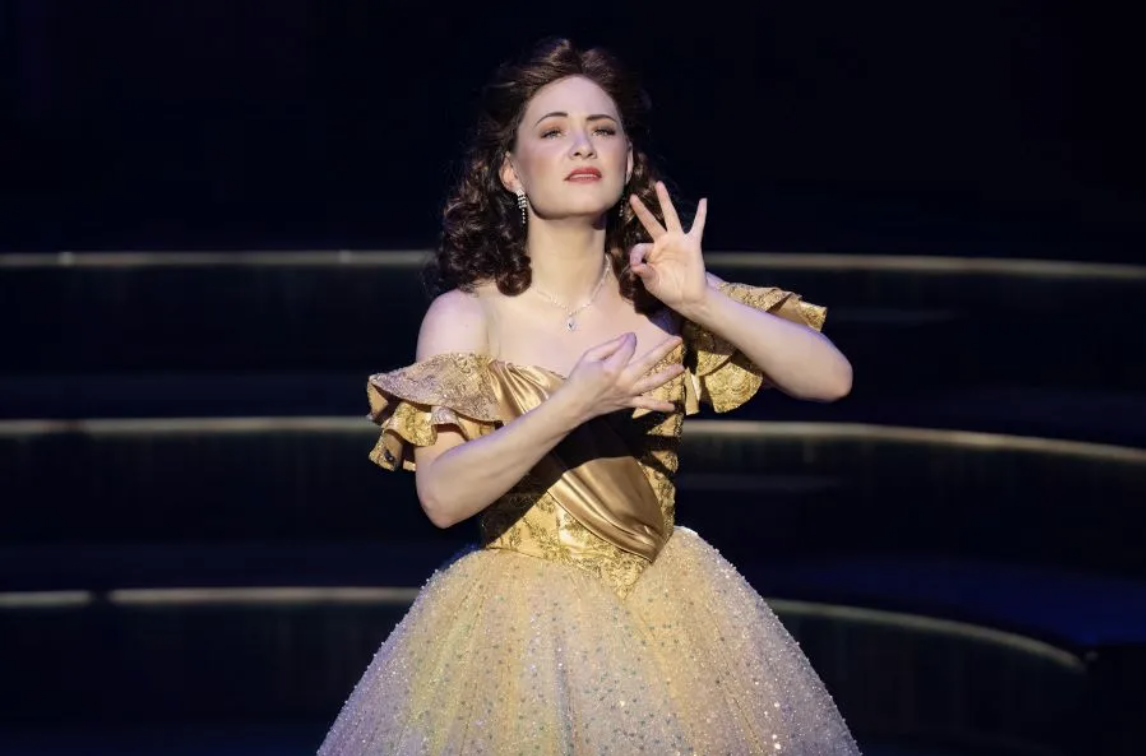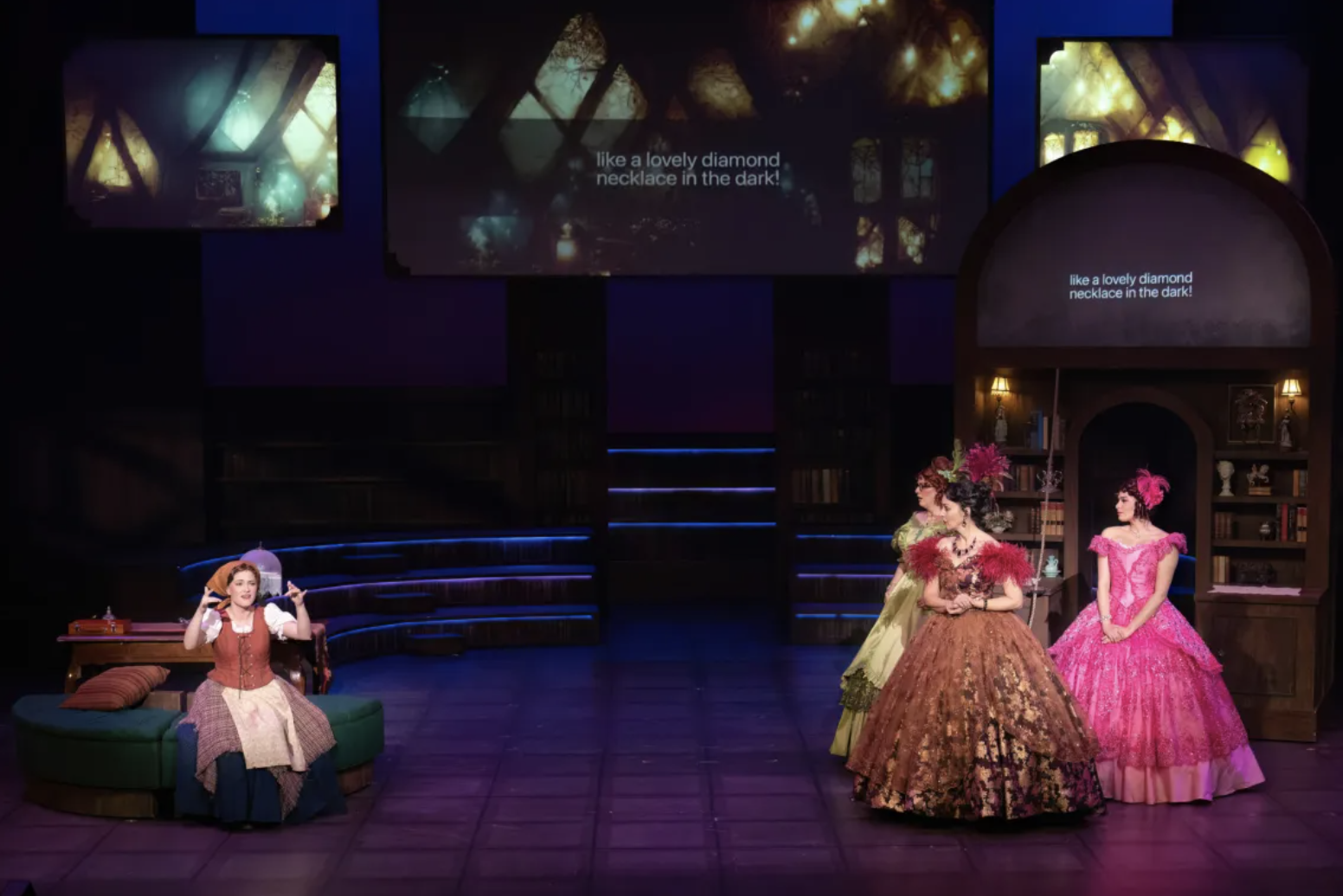Equal Accessibility for Deaf and Hearing Audiences? It’s Possible!
August 5, 2024
The beautiful thing about theatre is that there is never just one way to do it. Directors are able to take a piece and stage it in new and creative ways, while holding true to the story and the text. As a director who specializes in Deaf theatre, I look at each script to find ways to increase the accessibility. My goal is always to ensure that the show is accessible to both Deaf and hearing audiences, while finding ways to challenge the traditional theatre norms.
Traditionally, Deaf theatre has been staged with “shadow” actors or interpreters—i.e., every role is double cast with a Deaf actor and a hearing actor. This method has been used for many years. But in my opinion, it is quite oppressive to the Deaf actors. It requires that the Deaf actor share the spotlight with a hearing actor who is only providing the voice, while the Deaf actor is performing the embodied role. This method has often troubled me, because it sends the message that the Deaf actor’s language, American Sign Language (ASL), is not enough. Many companies will say that this bilingual approach is designed to make the show accessible to everyone. While the logic is sound, the result is that Deaf audiences have to focus harder on the signing actor, while having the visual distraction of the hearing actor. While hearing audiences’ attention may be split as well, there is never a danger that they will miss anything.
Take Deaf West’s Spring Awakening, for example. First, some qualifiers: I highly respect Deaf West and everyone involved on the show, as many of the Deaf artists involved are close personal friends. I am grateful for the show, as it really helped to put Deaf performers on the map in the industry and brought about an awareness that was needed, and I applaud the theatrical and Broadway community for welcoming this version of the show. I was lucky enough to see it on its closing night on Broadway.
All that said, while I was thrilled to see Broadway audiences falling in love with my friends and this production, as a Deaf audience member, I have to say it was not fully accessible to me, as it was designed for a hearing audience. I will admit that I do have the privilege of having some residual hearing left, and my hearing aids to help me experience the music. I saw the original Broadway cast years before and fell in love with the story and the music, so I knew the show by heart. This allowed me to note what was lacking in terms of accessibility.

During intermission, I spotted another audience member I knew from my time as a student at Gallaudet University. I knew he was profoundly Deaf, with no residual hearing. I asked him if he was enjoying the show so far. His face dropped, as he told me he could not follow the story; it was often hard to see the signing due to the lighting design, and the periodic projection of text on the set was often illegible due to placement and font choice, while the constant dual shadowing of hearing/Deaf casting was distracting.
I have met numerous Deaf people who felt the same way. When I have been contacted by theatre companies that want to do inclusive shows in the mode of Spring Awakening, I have to explain the problems with this model, which is entertaining for hearing audiences but inaccessible to many Deaf audiences. It was time for a change. I had been wanting to push those boundaries of accessibility and try something new. Enter ZACH Theatre in Austin, with an offer to collaborate with my company, Deaf Austin Theatre, on an ASL/English production of Rodgers & Hammerstein’s Cinderella, with a new book by Douglas Carter Beane. We brought on Michael Baron, artistic director of Lyric Theatre of Oklahoma, to co-direct the show with me because of his experiences co-directing with Sandra Mae Frank on a Deaf/hearing version staging of The Music Man at Olney Theatre Center in 2022.
As a Deaf director myself, I understand how important representation is, and Michael 100 percent agreed. So the first thing that we did was to carefully select a production team that was mixed with both Deaf and hearing professionals. The production team included music director Allen Robertson (hearing), lighting designer Annie Wiegand (Deaf), choreographer Cassie Abate (hearing), assistant choreographer Mervin Primeaux O’Bryant (Deaf), costume designer Jeffrey Meek (hearing), set/projection designer Stephanie Busing (hearing), and a director of ASL, Kailyn Aaron-Lozano (Deaf).
When discussing the storyline and the integration of Deaf culture, I had to decide which characters were Deaf, which were hearing, and which were hard of hearing. We already knew that Ella was going to be Deaf and Prince Topher was hearing. Jean-Michel, Ella’s friend, would be Deaf, while the Prince’s buddies, Sebastian and Lord Pinkleton, would be hearing and Deaf, respectively. Madame, Ella’s stepmother, would be hearing, while stepsister Charlotte would be hearing and stepsister Gabrielle hard of hearing. These distinctions also served the story: Madame, the stepmother, valued speech over any other communication, sharpening her dislike of Ella, who could not hear or speak, in contrast to her hearing and hard-of-hearing daughter.
In casting the show, we put together a group of 15 actors, seven Deaf and eight hearing. Sandra Mae Frank, best known for her work on NBC’s New Amsterdam and Deaf West’s Spring Awakening, stepped into the glass slippers as our Ella. To star opposite Sandra Mae as Prince Topher, we found Trey Harrington, a hearing actor who had been studying ASL for years; we decided to make the Prince a CODA (child of deaf adults).

In our staging of Cinderella—which ran at ZACH in early 2023 and is about to reopen at Lyric Theatre of Oklahoma in Oklahoma City—Michael and I threw out both what is traditional in musical theatre and what is traditional in Deaf theatre. We created a production where accessibility was an even platform for everyone, regardless if you were Deaf, hard of hearing, hearing, fluent in ASL, or completely ASL illiterate. Unlike the “shadowing” practice noted above, the Deaf characters Ella and Marie had no vocal counterpart for most of the show, including during songs like “My Own Little Corner” and “There Is Music in You.” The same was true in reverse for hearing/speaking characters like Madame and Sebastian, who had no ASL counterparts. Prince Topher would shift from speaking to signing to SimCom (simultaneous communication: signing and speaking at the same time), depending on who he was with.
How did these various audiences follow everything that was happening? The key: The entire production would have the English text and lyrics projected as supertitles onto the set throughout the show, so that at any point the text would be readily available when needed.
Throughout, I strove to use Deafness and hearing as part of the story. I wanted to bring in the dynamics of a typical Deaf/hearing relationship, along with all the hurdles and opportunities that presents. During the Prologue, we set the story in a modern library, with an ensemble pantomime that shows a modern-day Deaf girl bumping into a hearing boy. He tries to communicate with her but learns from the librarian that she is Deaf, so he finds an ASL dictionary and learns how to sign, “My name is…” But when he tries to communicate with her, he loses his nerve and runs off. Dejected, our modern-day Deaf girl dives into her favorite fable: Cinderella. As she opens the book, the story comes to life and the stage transforms.
Bookending this opening, at the finale we bring back our modern-day couple and see that he’s finally built up the nerve to talk to the beautiful Deaf girl and introduce himself, as the final notes of the music sound out, leading to a conclusion of hope and love for the young couple.
Signing, Not Singing
To spotlight the Deaf actors portraying characters we identified as Deaf, we wanted to honor their authentic language, which meant not adding voicing for their characters. So during Ella’s solo of “My Own Little Corner,” Sandra Mae Frank signs the song along with the music, but no vocals are heard. As a Deaf person, the first time I saw Sandra Mae signing the song along with the music, it gave me goosebumps because it was so empowering to see.
This inspired us to add more ASL songs without voicing, including songs between Ella and Topher, because it makes sense that he would want to communicate with her in her own language. Songs like “Ten Minutes Ago” and “Do I Love You Because You’re Beautiful” are performed in ASL, English voicing, and SimCom at moments that align with the progression of Ella and Topher’s relationship.
During ensemble songs like “The Prince Is Giving a Ball/Now Is the Time” and group songs like “When You’re Driving Through the Moonlight/A Lovely Night,” vocals of the lyrics are heard, but the singers are hidden among the ensemble or offstage so as not to distract from what was happening. Gabrielle, the hard-of-hearing stepsister, SimComs whenever Madame was around, but when it is just Ella and Gabrielle, they use ASL only, solidifying their relationship. This growing sisterhood is even more prominent in the reprise of “A Lovely Night.”
This device works the other way too: When Prince Topher is speaking with his right-hand man, Sebastian, with no other Deaf characters onstage, they speak only. But if Lord Pinkleton is around, the Prince uses SimCom so that Pinkleton is included in the conversation. For Pinkleton’s song, “The Prince Is Giving a Ball,” Sebastian voices the song while Pinkleton signs it. The Prince, meanwhile, progresses in his relationship with Ella, from SimCom to full signing with no voice. This corresponds with the natural development of a hearing person’s relationship with a Deaf person.
As Madame is one of the more oppressive characters, we wanted to make it clear that she does not like sign language and only values spoken language. This is a form of audism: i.e., the belief that the ability to hear makes you better than someone who cannot. So Madame crudely gestures with Ella and treats her as ignorant. Madame disapproves of Gabrielle’s relationship with Jean-Michel because he is Deaf and cannot speak.

Supertitles to the Rescue
Co-director Michael Baron was on board with the goal of full accessibility with the production, and also wanted to build on what learned from his experience with The Music Man, based on audience feedback regarding the placement of the supertitles.
Supertitles are captioning projected onto the set and ingrained within the set design. Captions, by contrast, are not fully accessible, because they are often placed in obscure locations, forcing Deaf audience members to look away from the stage/show in order to read the text. We wanted to ensure that the supertitles had a central home onstage, while also being free to move if the scenic action is happening stage right or stage left. Stephanie Busing, our set designer, was completely on board and integrated these surfaces into her design, while also taking on the role of projection/supertitle designer. This allowed for a streamlined vision of cohesion between the physical set and the projections.
The supertitles are projected onto a large framed canvas descended from the fly system in the stage center position. But if Cinderella’s house happens to move far stage left or right, the supertitles are projected on the archway representing her house. The goal is to ensure that the text and the actors are all within the audience’s field of vision at all times throughout the show.
Some people have asked me why we have songs and dialogue without voicing, and my response to that is…why not? Why does everything have to be voiced? If Deaf audiences are always having to determine which mode of accessibility they will take advantage of during a show (ASL interpreters or captions), then why can’t hearing audiences also adapt? With this staging, everyone has to do a bit of work, turning to the supertitles when the text onstage is not accessible to them. No person has an advantage over the other—unless you are a hearing person who is fluent in ASL. Then you have the best of both worlds.
Honestly, while I’m very proud of what we’ve done with Cinderella, this should not be a rare or special occasion. Deaf actors should be considered, and supertitles included, in every production. That way Deaf audiences would not be limited to booking tickets on specific nights, but have the equitable option of choosing any night to attend the show.
This new wave of accessible theatre can be implemented in any venue across the U.S. and beyond. Want to see how it is done? Cinderella is playing at Lyric Theatre of Oklahoma City, July 30-Aug. 4.
Article by Dr. Brian Andrew Cheslik. Dr. Cheslik is the managing artistic director of Deaf Austin Theatre and the program director for the American Sign Language & Interpretation program at the University of Texas Rio Grande Valley, as well as a Certified Deaf Interpreter.